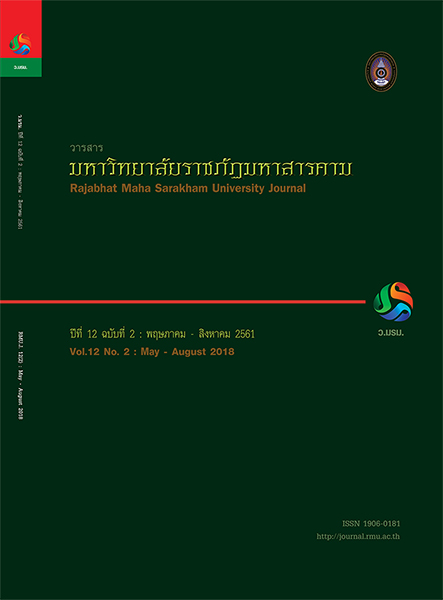รูปแบบการจัดการเรียนรู้ร่วมมือแบบเกมิฟิเคชั่นออนไลน์
Main Article Content
บทคัดย่อ
การวิจัยครั้งนี้มีวัตถุประสงค์ เพื่อสังเคราะห์รูปแบบการเรียนรู้ร่วมมือแบบเกมิฟิเคชั่นออนไลน์และเพื่อประเมินรูปแบบการเรียนรู้
ที่สังเคราะห์ขึ้น วิธีการดำเนินการวิจัยเป็น 2 ขั้นตอน ได้แก่ 1) การสังเคราะห์รูปแบบการเรียนรู้โดยการสัมภาษณ์เชิงลึก กลุ่มตัวอย่าง
เป็นผู้เชี่ยวชาญในด้านการพัฒนารูปแบบ คัดเลือกกลุ่มตัวอย่างแบบเจาะจง จำนวน 12 คน และ 2) การประเมินรูปแบบการเรียนรู้
กลุ่มตัวอย่างเป็นผู้ทรงคุณวุฒิด้านการประเมินรูปแบบการเรียนรู้ คัดเลือกกลุ่มตัวอย่างแบบเจาะจง จำนวน 7 คน เก็บข้อมูลโดยใช้
แบบประเมินความเหมาะสมของรูปแบบการเรียนรู้ วิเคราะห์ข้อมูลโดยหาค่าเฉลี่ยและส่วนเบี่ยงเบนมาตรฐาน
ผลการวิจัยพบว่ารูปแบบการเรียนรู้ร่วมมือแบบเกมิฟิเคชั่นออนไลน์ที่สังเคราะห์ขึ้นมี 5 องค์ประกอบ คือ 1) ด้านเกมิฟิเคชั่น
2) ด้านการเรียนแบบร่วมมือ 3) ด้านแหล่งเรียนรู้ 4) ด้านการประเมินผล และ 5) ด้านการเสริมศักยภาพการเรียนรู้ โดยมีกระบวนการ
เรียนรู้ 5 ขั้นตอน (5A) คือ 1) กระตุ้นความคิด 2) ภารกิจเบื้องต้น 3) ผจญภัย 4) วินิจฉัยผลงาน และ 5) วิจารณ์สะท้อนผล และ
การประเมินรูปแบบการเรียนรู้จากผู้ทรงคุณวุฒิ โดยแบ่งเป็น 4 ด้าน พบว่า 1) ด้านหลักการและแนวคิดของรูปแบบการเรียนรู้ มีความ
เหมาะสมในระดับมาก 2) ด้านองค์ประกอบของรูปแบบการเรียนรู้ มีความเหมาะสมในระดับมาก 3) ด้านกลยุทธ์การจัดการเรียนรู้
มีความเหมาะสมในระดับมาก และ 4) ด้านประโยชน์การใช้งาน มีความเหมาะสมในระดับมาก จึงสรุปได้ว่า รูปแบบการเรียนรู้ที่
สังเคราะห์ขึ้น มีผลการประเมินความเหมาะสมอยู่ในระดับมาก สามารถนำไปเป็นต้นแบบในการพัฒนาเครื่องมือในการจัดการเรียนรู้ได้
Article Details
1. บทความที่ลงตีพิมพ์ทุกเรื่องได้รับการตรวจทางวิชาการโดยผู้ประเมินอิสระ ผู้ทรงคุณวุฒิ (Peer Review) สาขาที่เกี่ยวข้อง อย่างน้อย 3 ท่าน ในรูปแบบ Double blind review
2. ข้อคิดเห็นใด ๆ ของบทความที่ลงตีพิมพ์ในวารสารมหาวิทยาลัยราชภัฏมหาสารคาม นี้เป็นของผู้เขียน คณะผู้จัดทำวารสารไม่จำเป็นต้องเห็นด้วย
3. กองบรรณาธิการวารสารมหาวิทยาลัยราชภัฏมหาสารคาม ไม่สงวนสิทธิ์การคัดลอกแต่ให้อ้างอิงแสดงที่มา
เอกสารอ้างอิง
Thailand 4.0. 20 November 2017 From : http://
planning2.mju.ac.th/goverment/20111119104835_
planning/Doc_25590823143652_358135.pdf
[2] Vicharn Panich. (2012). 21st Century Learning Path
for Disciples. Bangkok : Sodsri-Saridwong
Foundation.
[3] Prensky, M. (2001). Digital Natives, Digital
Immigrants. On the Horizon, 9(5), 1-6.
[4] Thunyalak Weerasombut. (2014). How to survive
in “ASEAN”?:When New Graduates Challenge, Not
Just English. 21 November2017. From : http://www.
matichon.co.th/news_detail.php?newsid
=1348642687
[5] KhonThaiFoundation. (2014). Research of Thai
People Monitor 2014 :Thai Youth Voice. 21
November 2016 : http://www.khonthaifoundation.
org/news-detail.php?id=47
[6] Juthamart Meesuk, Sanit Teemuangsai and
Phongthorn Phoophoosak. (2015). Enhancing
student participation behavior engagement
through gamificationfor enrichment Science Class
students Mathayomsuksa IV Anukoolnaree School.
National and international conferences, “The
Research Rajabhat III on 20-22 May 2015 at Nakhon
Si Thammarat Rajabhat University.
[7] Teemuangsai, S. & Meesook, C. (2017). Thailand’s
classroom learning practices in secondary level :
Are we ready for learning in the 21st-Century?.
International Journal of Science and Technology
Education Research, 8(1), 1-12.
[8] Pichayaqh Chokpon (2015). The Enhancment
Cooperative Behavior by Using Gamification Ap
proach for Matthayomsueksa 4 Enrichment
Sciences Claarom Students of Phadungnaree
School. Master of Edacation Thesis (Computer
Education Program) Rajabhat Mahasarakham
University.
[9] Vicharn Panich. (2013). Teacher for Disciples : The
Flipped Classroom Creating. Bangkok : SA PR
PRINTING MASS PRODUCTS.
[10] Chou, Yu-kai. (2013). What Is Gamification.
Retrieved 25 November 2017from http://www.
yukaichou.com/gamification-examples/what-isgamification
[11] Fernandes, J., Duarte, D., Ribeiro, C., Farinha, C.,
Pereira, J. & Silva, M. (2012). iThink: A
game-based Approach towards Improving
Collaboration and Participation in Requirement
Elicitation. Procedia Computer Science, 15(2012),
66-77.
[12] O’Donovan, S., Gain, J. & Marais, P. (2012). A Case
Study in the Gamification of a University-level
Games Development Course. Elsevier Ltd.
[13] Moradian, A., Leung, R., Nasir, M., Sim, S., &
Lyons, K. (2014). Gamification of Collaborative
Idea Generation and Convergence. Toronto,
Canada : CHInd.
[14] Tissana Khammanee. (2011). Teaching science
: Knowledge for effective learning process. 14th
Ed. Bangkok : Chulalongkorn University.
[15] Kapp, K. (2012). The Gamification of Learning and
Instruction : Game-based Methods and Strategies
for Training and Education. California, CA :
Pfeiffer.
[16] Zichermann, G. & Cunningham, C. (2011).
Gamification by Design Implementing Game
Mechanics in Web and Mobile Apps (1st ed.).
Sebastopol : O’Reilly Media.
[17] Diggelen, M. (2012). The Principles of Gamification.
Retrieved 9 December 2016 from http://www.woba
long.com/gamification-consulting-by-gamifycon
sultant-com/
[18] Zimbrick, J. (2013). Is Gamification a Positive
Learning Trend?. Retrieved 9 December 2017from
http://www.coetail.com/jzimbrick/2013/12/01/
is-gamification-a-positive-learning-trend/
[19] Jonassen, D. H. (1995). Supporting Communities
of Learners with Technology : A Vision for
Integrating Technology with Learning in Schools.
Educational Technology, 35(4), 60-63.
[20] Thanomporn Laohajaratsang. (2002). Designing
e-Learning : Principles of Web Design and
Creation for Teaching. Bangkok : Arun Printing.
[21] Dom-nguez, A., Saenz-de-Navarrete, J., de-Marcos,
L., Fernández-Sanz, L., Carmen Pagés, C., & Martnez-
Herráiz J. (2012). Gamifying Learning
Experiences : Practical Implications and
Outcomes. Computers & Education, 63,
380-392.
[22] McGrath, N., & Bayerlein, L. (2013). Engaging
Online Students through The Gamification of
Learning Materials : The Present and The Future.
30th ascilite Conference 2013 Proceedings,
Macquarie University, Sydney, 1-4 December,
573-577.
[23] Wolff, J. (2014). The Gamification of Education
and Cognitive, Social, and Emotional Learning
Benefits. Retrieved 20 December 2017from http://
www.emergingedtech.com/2012/06/the-gamification
-of-education-and-cognitive-social-and-emotionallearning-
benefits/
[24] Denny, J. (2014). Gamification : Make Education
Entertaining to Secure Learner Engagement.
Retrieved 25 November 2017fromhttp://elearningin
dustry.com/gamification-make-educationentertaining-
secure-learner-engagement
[25] Eggen, P. & Kauchak, D. (1997). Education
Psychology (3rd ed). New Jersey : Prentice-Hall.
[26] Marzano, R. J. & et al. (2001). Dimension
of thinking: a Framework for curriculum and in
struction, Ahghar (Translato), Tehran : Yastaroun
[27] Parsons, J. M., & Taylor, L. (2006). Celebrating
School Improvement : Six Lessons from Alberta’s
AISI Projects. Edmonton : School Improvement
Press.
[28] Natasha A. R., Daniel Kok Hoong Yip, & Shi Chen
Baey. (2009). The Role of Teacher, Student and
ICT in Enhancing Student Engagement in
Multiuser Virtual Environments. British Journal
of Educational Technology, 40(1), 61-69.
[29] Kaplan University School of Information
Technology. (2013). CASE STUDY: KAPLAN
UNIVERSITY. Retrieved 26 January 2018, from
http://badgeville.com//customer/case-study/
kaplan-university


